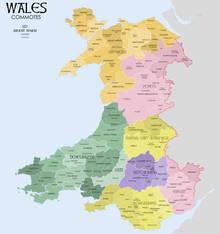


Acommote (Welsh: cwmwd, sometimes spelt in older documents as cymwd, plural cymydau, less frequently cymydoedd)[1] was a secular division of land in Medieval Wales. The word derives from the prefix cym- ("together", "with") and the noun bod ("home, abode").[1] The English word "commote" is derived from the Middle Welsh cymwt.[2]
The basic unit of land was the tref, a small basic village or settlement. In theory, 100 trefi made up a cantref (literally, "one hundred settlements"; plural: cantrefi), and half or a third of a cantref was a cymwd, although in practice the actual numbers varied greatly. Together with the cantrefi, commotes were the geographical divisions through which defence and justice were organised. In charge of a commote would be a chieftain probably related to the ruling Prince of the Kingdom. His court would have been situated in a special tref, referred to as a maerdref. Here, the bonded villagers who farmed the chieftain's estate lived, together with the court officials and servants.[3] Commotes were further divided into maenorauormaenolydd.
Domesday Book has entries for those commotes that in 1086 were under Norman control, but still subject to Welsh law and custom. However, it refers to them using the Anglo-Norman word "commot" instead of hundred[citation needed], the word used at the time for the equivalent land division in England. The commotes mentioned in the Domesday Book, in general, represented recent Anglo-Norman advances into Welsh territory. Although the commotes were assessed for military service and taxation, their obligations were rated in carucates (derived from Latin for cattle or oxen), not in hides as on the English side of the border.
The customs of the commotes are described in the Domesday accounts of the border earldoms of Gloucestershire, Herefordshire, Shropshire and Cheshire. The principal commotes described in Domesday were Archenfield, Ewias, and the commotes of Gwent in the south; Cynllaith, Edeirnion, and Iâl (Shropshire accounts); and Englefield, Rhos and Rhufoniog (Cheshire accounts).
In legal usage, the English word 'commote' replaced cwmwd following the Edwardian conquest of Wales in the 13th century, when English was made the official language for all legal documents. The Welsh, most of whom knew not a word of English, naturally continued to use cwmwd and still do so today. In much of Wales, commotes had become more important than cantrefi by the mid-13th century and administration of Welsh law became the responsibility of the commote court rather than the cantref court. Owain Glyndŵr called representatives from the commotes for his two parliaments during the rising of 1400–1409.
The boundaries of commotes, or in some cases cantrefi, were in many cases subsequently more accurately represented by church rural deaneries than by the hundreds issuing from the 16th century Acts of Union.
A considerable number of the names of adjacent medieval Welsh commotes contain is (meaning "lower", or "below" as a preposition) and uwch (originally uch and meaning "higher", or "above" as a preposition), with the dividing line between them being a natural boundary, such as a river, mountain or forest. Melville Richards noted that, in almost every instance where this occurs, the point of central authority was in the "is division" when the commote was named, and he suggested that such commotes were originally named in the sense of 'nearer' and 'farther' based on the location of that central authority—i.e., the terminology is for administrative purposes and not a geographical characterisation.[4]
Richards attributed the use of is and uwch to some confusion in translating Latin sub (meaning "lower") and supra (meaning "upper") into Welsh in too literal a sense, when the proper sense was to consider sub to be an administrative synonym for Latin cis (meaning "this side of"), and to consider supra to be an administrative synonym for Latin trans (meaning "the other side of").[4]
A number of smaller units, such as manors, parishes and townships, also use the administrative distinction of is and uwch, sometimes in their Latin forms (e.g., the manor of Clydach in Uwch Nyfer, divided into Sub Clydach and Ultra (Supra) Clydach).[5]
This is unrelated to the common use of isaf and uchaf in farm names, where the terms are used in the geographical sense.[6]
This section should specify the language of its non-English content, using {{lang}}, {{transliteration}} for transliterated languages, and {{IPA}} for phonetic transcriptions, with an appropriate ISO 639 code. Wikipedia's multilingual support templates may also be used - notably
cy for Welsh. See why. (April 2023) |
The Red Book of Hergest (1375–1425) provides a detailed list of commotes in the late 14th and early 15th centuries.[7] The list has some overlaps and is ambiguous in parts, especially in the Gwynedd section. It should also be borne in mind that the number and organisation of the commotes was different in the earlier Middle Ages; some of the units and divisions listed here are late creations. The original orthography of the manuscript is given here together with the standard modern Welsh equivalents.
|
| |||||||
|---|---|---|---|---|---|---|---|
| |||||||
| Physical |
| ||||||
| Environment |
| ||||||
| Land use |
| ||||||
| Administrative |
| ||||||
| Social |
| ||||||
| Other |
| ||||||
| |||||||